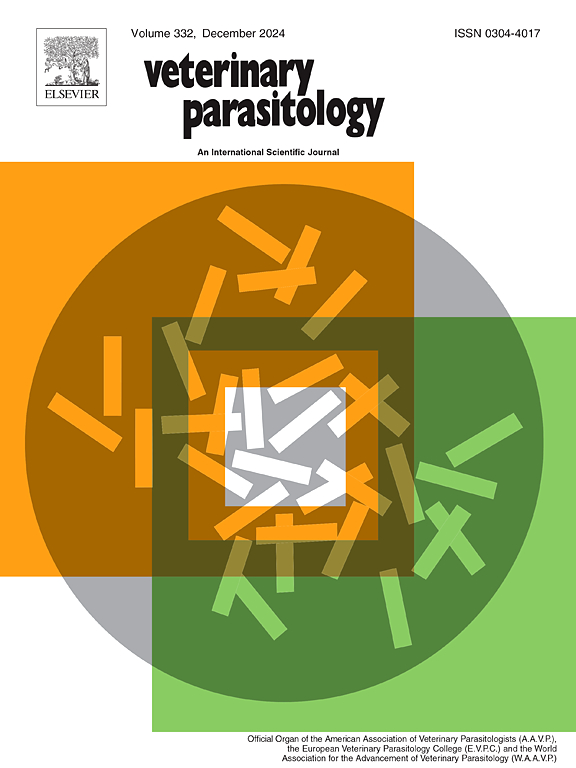Enhanced apoptosis, inflammatory cellularity, collagen deposition, and interaction between fibroblasts and Leishmania amastigotes in undamaged ear skin of dogs with leishmaniosis
IF 2
2区 农林科学
Q2 PARASITOLOGY
引用次数: 0
Abstract
Fibroblasts are located close to the area of skin inoculation of Leishmania promastigotes. They are a potential cellular target for early parasite infection, harboring amastigotes of Leishmania spp. This study aimed to determine the apoptosis in fibroblasts, and to correlate these results with inflammation, parasite load, AgNOR (Argyrophilic Nucleolar Organizer Region) index, and clinical features in Leishmania-affected dogs. Fragments from the undamaged ear skin of 16 Leishmania-infected and seven uninfected dogs were evaluated by histomorphometry and immunohistochemical analysis, which correlated fibroblast apoptosis to clinical manifestation and parasite load. Ultra-thin sections were examined under transmission electronic microscopy (TEM). When applying immunohistochemical analysis, Leishmania amastigotes were only found in clinically affected dogs. The cellularity of the inflammatory infiltrate and the AgNOR index (fibroblasts and inflammatory infiltrate) were higher in clinically affected dogs. The collagen deposition score was statistically significantly higher in Leishmania-infected dogs. The apoptotic index of inflammatory cells and fibroblasts proved to be higher in clinically affected dogs. From an ultrastructural point of view, apoptotic cells shrank, while the nuclear chromatin and cytoplasm condensed. Amastigotes were observed within inflammatory cells (neutrophils and macrophages) and in the inner portions of fibroblasts. Fibroblast apoptosis was related to both the increase in the parasite load and the intensity of the inflammatory response. Histomorphometric assessments (inflammation, parasite load, AgNOR index, and apoptosis) and clinical manifestations were also associated. Collagen deposition was positively correlated with AgNOR expression and the apoptotic index (inflammatory cell and fibroblast). Therefore, fibroblast apoptosis contributes to the infection process, pathogenesis, and chronicity of canine leishmaniosis. Moreover, fibroblasts may well provide an escape mechanism for immune defenses against Leishmania.
利什曼病犬未损伤耳皮中细胞凋亡、炎性细胞、胶原沉积及成纤维细胞与利什曼原虫间相互作用增强
成纤维细胞位于靠近利什曼原虫的皮肤接种区域。它们是早期寄生虫感染的潜在细胞靶点,含有利什曼原虫的无轴线虫。本研究旨在确定成纤维细胞的凋亡情况,并将这些结果与利什曼感染犬的炎症、寄生虫负荷、AgNOR(嗜银核仁组织区)指数和临床特征联系起来。采用组织形态学分析和免疫组化分析方法,对16只感染利什曼原虫和7只未感染利什曼原虫的狗耳皮肤的未损伤片段进行了评价,分析了成纤维细胞凋亡与临床表现和寄生虫负荷的关系。在透射电镜下观察超薄切片。应用免疫组化分析,利什曼原虫仅在临床感染犬中发现。临床感染犬炎症浸润的细胞数量和AgNOR指数(成纤维细胞和炎症浸润)均较高。利什曼感染犬的胶原沉积评分具有统计学意义。临床感染犬炎症细胞和成纤维细胞的凋亡指数较高。从超微结构上看,凋亡细胞收缩,核染色质和细胞质浓缩。在炎症细胞(中性粒细胞和巨噬细胞)和成纤维细胞内部观察到无尾线虫。成纤维细胞凋亡与寄生虫负荷的增加和炎症反应的强度有关。组织形态学评估(炎症、寄生虫负荷、AgNOR指数和细胞凋亡)和临床表现也相关。胶原沉积与AgNOR表达和凋亡指数(炎症细胞和成纤维细胞)呈正相关。因此,成纤维细胞凋亡参与了犬利什曼病的感染过程、发病机制和慢性。此外,成纤维细胞很可能为免疫防御利什曼原虫提供了一种逃避机制。
本文章由计算机程序翻译,如有差异,请以英文原文为准。
求助全文
约1分钟内获得全文
求助全文
来源期刊

Veterinary parasitology
农林科学-寄生虫学
CiteScore
5.30
自引率
7.70%
发文量
126
审稿时长
36 days
期刊介绍:
The journal Veterinary Parasitology has an open access mirror journal,Veterinary Parasitology: X, sharing the same aims and scope, editorial team, submission system and rigorous peer review.
This journal is concerned with those aspects of helminthology, protozoology and entomology which are of interest to animal health investigators, veterinary practitioners and others with a special interest in parasitology. Papers of the highest quality dealing with all aspects of disease prevention, pathology, treatment, epidemiology, and control of parasites in all domesticated animals, fall within the scope of the journal. Papers of geographically limited (local) interest which are not of interest to an international audience will not be accepted. Authors who submit papers based on local data will need to indicate why their paper is relevant to a broader readership.
Parasitological studies on laboratory animals fall within the scope of the journal only if they provide a reasonably close model of a disease of domestic animals. Additionally the journal will consider papers relating to wildlife species where they may act as disease reservoirs to domestic animals, or as a zoonotic reservoir. Case studies considered to be unique or of specific interest to the journal, will also be considered on occasions at the Editors'' discretion. Papers dealing exclusively with the taxonomy of parasites do not fall within the scope of the journal.
 求助内容:
求助内容: 应助结果提醒方式:
应助结果提醒方式:


